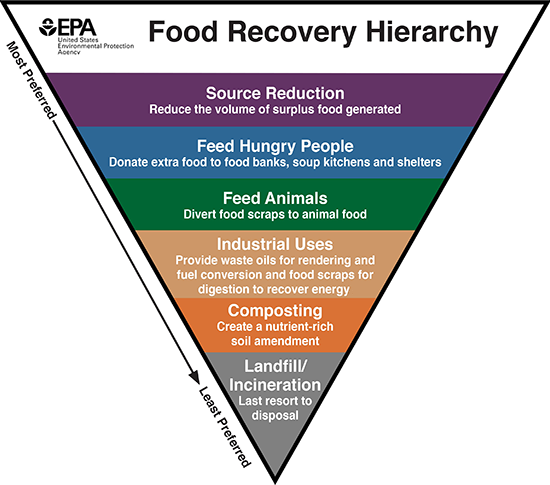Industrial Uses for Wasted Food
On this page

The fourth tier of EPA's Food Recovery Hierarchy is industrial uses. Food can be used to not only feed people and animals, but also power your car or generator. There is increasing interest in finding effective means to obtain biofuel and bio-products from wasted food. These options aim to alleviate some of the environmental and economic issues associated with wasted food while increasing the use of alternative energy sources.
Anaerobic Digestion
Anaerobic digestion is a process where microorganisms break down organic materials, such as food scraps, manure, and sewage sludge. This is done in the absence of oxygen. Recycling wasted food through anaerobic digestion produces biogas and a soil amendment, two valuable products.
Wasted food can be processed at facilities specifically designed to digest the organic portion of municipal solid waste. It can also be co-digested at wastewater treatment plants and manure digesters.
What are industrial uses of fats, oil, and grease?
Liquid fats and solid meat products are materials that should not be sent to landfills or disposed of in the sanitary sewer system. Fats, oils, and grease can clog pipes and pumps both in the public sewer lines as well as in wastewater treatment facilities. This prevents combined sewer overflows, which protects water quality and lowers bills. Fats, oil and grease should be sent to the rendering industry to be made into another product, converted to biofuels, or sent to an anaerobic digester.
- Rendering - Liquid fats and solid meat products can be used as raw materials in the rendering industry, which converts them into animal food, cosmetics, soap, and other products. Many companies will provide storage barrels and free pick-up service.
- Biodiesel - Fats, oils and grease are collected and converted by local manufacturers into environmentally friendly biodiesel fuel. Biodiesel is an alternative fuel produced from renewable resources such as virgin oils (soybean, canola, palm), waste cooking oil, or other biowaste feedstock. Biodiesel significantly reduces greenhouse gases, sulfur dioxide in air emissions, and asthma-causing soot. Along with creating less pollution, biodiesel is simple to use, biodegradable and nontoxic.
- Anaerobic Digestion - Fats, oil and grease can be added to anaerobic digesters at wastewater treatment plants to generate renewable energy in the form of biogas.
Success Stories
Disclaimer of Endorsement: Reference herein to any specific commercial products, process, or service by trade name, trademark, manufacturer, or otherwise, does not necessarily constitute or imply its endorsement, recommendation, or favoring by the United States Government. The views and opinions of authors expressed herein do not necessarily state or reflect those of the United States Government, and shall not be used for advertising or product endorsement purposes.
Des Moines Metropolitan Wastewater Reclamation Authority
The Des Moines Metropolitan Wastewater Reclamation Authority operates the Wastewater Reclamation Facility (WRF) in Des Moines, Iowa, which is home to six, 2.7 million-gallon anaerobic digesters. The WRF operates one of the largest hauled waste receiving programs in the nation, accepting over 60 truckloads per day, most of which is commercial fats, oils, & grease; food waste; and high-strength organic waste from various industrial processing facilities across a four-state region. These organic-based hauled wastes are mixed and co-digested with municipal sludge, which produces two products: biogas and biosolids. In 2017, the WRF generated an average of over 2.1 million cubic feet of biogas per day. Currently, the biogas/biomethane is used onsite to heat boilers and to fuel two, 1.4-megawatt engine generators. A portion of the biogas is also sold to a nearby industrial facility for boiler fuel. Soon, the WRF will begin diverting all of its purified biomethane to the local natural gas pipeline utility. Biosolids extracted from the anaerobic digesters are recycled back into the environment via land application, which returns valuable macro- and micronutrients back into the soil of the surrounding agricultural land.
Purdue University
Purdue University turns wasted food into renewable energy by partnering with the City of West Lafayette to send food waste to the local wastewater treatment plant. At the wastewater treatment plant, the food is added to the anaerobic digester, where it is processed by microbes to generate biogas, a source of renewable energy, and a solid residual that can be used as a soil amendment. Learn more about this partnership from the City of West Lafayette presentation about its waste to energy efforts.
The University of Wisconsin Oshkosh
The University of Wisconsin Oshkosh started turning organic materials into renewable energy in fall 2011 with a dry fermentation anaerobic digester. The first of its kind in the nation, this facility uses agricultural plant waste, City of Oshkosh yard waste, and wasted food generated on campus to produce biogas. The digester produces enough energy to power up to 10 percent of the 13,500-student institution.
East Bay Municipal Utility District (EBMUD)
East Bay Municipal Utility District (EBMUD) in Oakland, CA was the first wastewater treatment plant in the nation to convert post-consumer food scraps to energy via anaerobic digestion. Waste haulers collect post-consumer wasted food from local restaurants and markets and take it to EBMUD. In an anaerobic digester, bacteria break down the wasted food and release methane as a byproduct. EBMUD then captures the methane and uses it as a renewable source of energy to power the treatment plant. After the digestion process, the leftover material can be composted and used as a natural fertilizer.
